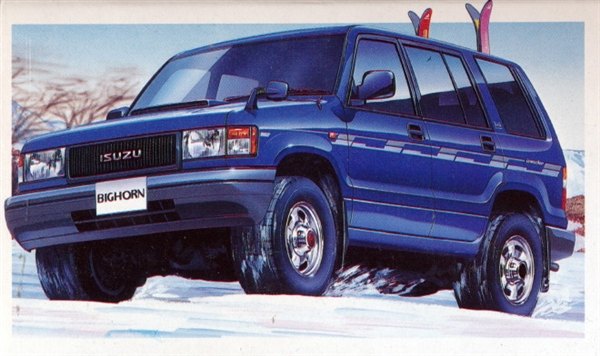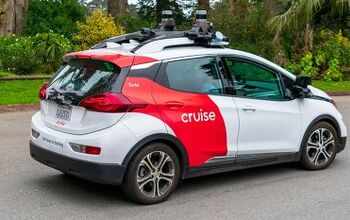Rare Rides: The 1994 Isuzu Trooper That's Bighorn and Irmscher

Rare Rides featured Isuzu vehicles on four previous occasions, and all of them were from the Seventies or Eighties.
Today we switch it up a bit and present an Isuzu from the Nineties. Ready for Irmscher?
The Isuzu Trooper entered production in 1981, and like almost all SUVs of the period was a basic and utilitarian way to get from A to B with no road between. The Trooper wore many different brand and model badges, as Isuzu boss General Motors ensured it had as wide a spread as possible. The Trooper was available in different configurations throughout its life as a Honda, Opel, Vauxhall, Holden, Acura, SsangYong, and Subaru.
Trooper’s first generation lasted through 1991 when the truck was replaced for the 1992 model year by a more modern, more luxurious Trooper. In addition to more standard equipment, Trooper was now considerably larger and more powerful. Chrome accents appeared everywhere, alloy wheels brought two-tone paint schemes more upscale, and some models sprouted headlamp wipers like fancy European cars.
Second-gen Troopers were powered by inline-four diesel engines, or three different V6 mills that ranged in displacement from 3.2- to 3.5-liters. A five-speed manual was the preferred transmission in most markets, but North American examples were largely equipped with an overstressed GM four-speed automatic. Isuzu also made the unwise decision not to sell the seven-passenger version Trooper in North America, though it was available in most other markets.
Like the first generation, two- and four-door body styles were initially available on the second Trooper. The shorter version proved unpopular in North America, and it was discontinued after 1995. 1996 brought along the extra luxurious Acura SLX version, and a visual refresh for 1998 modernized the Trooper a bit: It wore a revised front clip and new wheels. Trooper lived on through 2002 before cancellation. Domestically it was replaced by the relatively bad Isuzu Axiom and the relatively bad GMT-360 Isuzu Ascender. Poor Isuzu.
Along the way, a select few Bighorn (RHD branding) examples of both Trooper generations were modified by German tuning company Irmscher. Largely a visual edit, Bighorns received branded tape stripes, tire covers, and color match monoblock wheels on the outside. The interior featured stripy Recaro seats, an Irmscher steering wheel, and nothing else. Today’s 1994 example uses the 3.1-liter turbodiesel engine that wasn’t available in the US, paired with an automatic. It sold at a dealer in Seattle recently.
[Images: Isuzu]

Interested in lots of cars and their various historical contexts. Started writing articles for TTAC in late 2016, when my first posts were QOTDs. From there I started a few new series like Rare Rides, Buy/Drive/Burn, Abandoned History, and most recently Rare Rides Icons. Operating from a home base in Cincinnati, Ohio, a relative auto journalist dead zone. Many of my articles are prompted by something I'll see on social media that sparks my interest and causes me to research. Finding articles and information from the early days of the internet and beyond that covers the little details lost to time: trim packages, color and wheel choices, interior fabrics. Beyond those, I'm fascinated by automotive industry experiments, both failures and successes. Lately I've taken an interest in AI, and generating "what if" type images for car models long dead. Reincarnating a modern Toyota Paseo, Lincoln Mark IX, or Isuzu Trooper through a text prompt is fun. Fun to post them on Twitter too, and watch people overreact. To that end, the social media I use most is Twitter, @CoreyLewis86. I also contribute pieces for Forbes Wheels and Forbes Home.
More by Corey Lewis
Latest Car Reviews
Read moreLatest Product Reviews
Read moreRecent Comments
- El scotto UH, more parking and a building that was designed for CAT 5 cable at the new place?
- Ajla Maybe drag radials? 🤔
- FreedMike Apparently this car, which doesn't comply to U.S. regs, is in Nogales, Mexico. What could possibly go wrong with this transaction?
- El scotto Under NAFTA II or the USMCA basically the US and Canada do all the designing, planning, and high tech work and high skilled work. Mexico does all the medium-skilled work.Your favorite vehicle that has an Assembled in Mexico label may actually cross the border several times. High tech stuff is installed in the US, medium tech stuff gets done in Mexico, then the vehicle goes back across the border for more high tech stuff the back to Mexico for some nuts n bolts stuff.All of the vehicle manufacturers pass parts and vehicles between factories and countries. It's thought out, it's planned, it's coordinated and they all do it.Northern Mexico consists of a few big towns controlled by a few families. Those families already have deals with Texan and American companies that can truck their products back and forth over the border. The Chinese are the last to show up at the party. They're getting the worst land, the worst factories, and the worst employees. All the good stuff and people have been taken care of in the above paragraph.Lastly, the Chinese will have to make their parts in Mexico or the US or Canada. If not, they have to pay tariffs. High tariffs. It's all for one and one for all under the USMCA.Now evil El Scotto is thinking of the fusion of Chinese and Mexican cuisine and some darn good beer.
- FreedMike I care SO deeply!



































Comments
Join the conversation
The GM 2.8 V6 and Isuzu 2.6 I4 were the standards of the world! At least if you had a tailwind. I had an '88 and a '92, both with the 2.4. As I have pointed out, the Trooper was one of the few trucks with disc brakes all around in the 1980s and the I4 had port injected EFI. Cutting edge for the time. I imagine the EFI was developed so it wouldn't stall when carb float bowls were canted near 45 degrees. I installed aftermarket cruise control on both and every Interstate Highway slope required right foot assist to maintain speed while in cruise. When I lived on Kentucky Lake in the 1990's, there was a tornado and dechero winds and a friend's resort and marina got trashed. While they were rebuilding the marina I was given possession of a 20 ft dock section for my lakefront that was blown ashore. It ended up in a low area that was grassy but wet. A friend's RAM 1500 couldn't pull it out of the damp but I backed up the Trooper, selected 4-Low, and away it went. Of course for transport it was loaded onto a trailer towed by the RAM.
I have a 1986 Trooper Turbo Diesel 2.2 liter. It's a US spec truck. Sold here in the States for only a year. Love it.